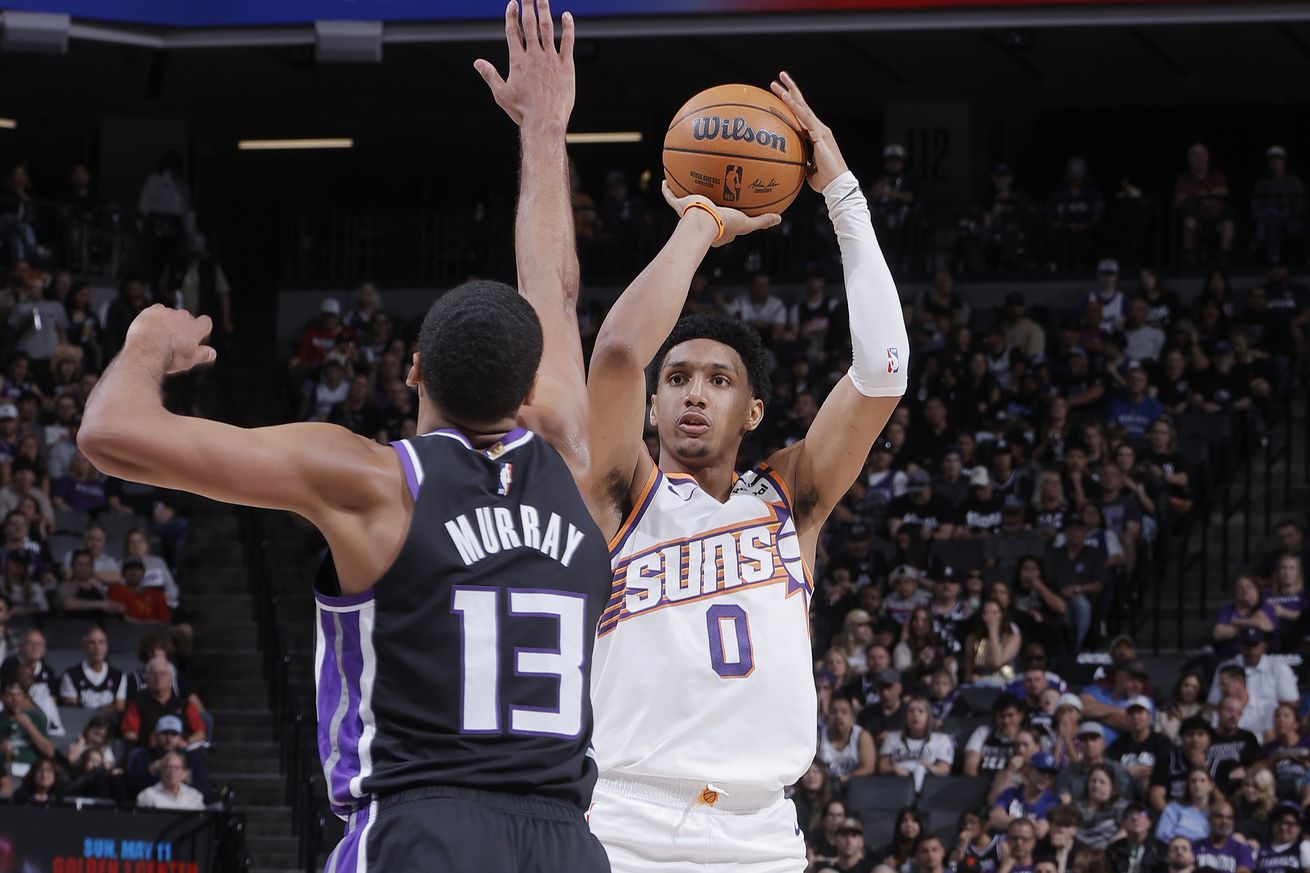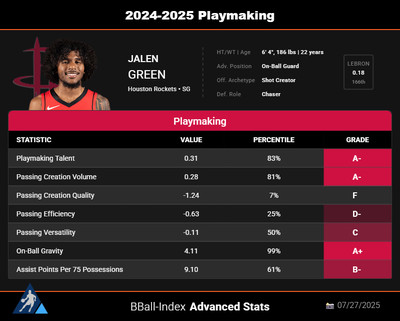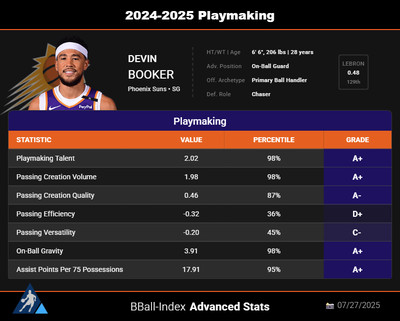
Why playmaking, shot creation, and shooting are the biggest questions for Phoenix next season.
As the season lingers just beyond the horizon, still two months out from even a whiff of preseason, I find myself staring at this newly assembled Phoenix Suns roster. And honestly? I feel…satisfied. Not elated, not giddy. Just a quiet, measured satisfaction. Because, unlike last year, this team feels like it might actually know who it is.
Identity. It should exist. It’s a team that should hustle, that should defend, that should put pressure on the rim. All the things that were painfully absent a season ago. And because of that, we ended up watching the most aimless version of the Suns since 2019. So yeah, shifting the pendulum in the opposite direction deserves at least a polite golf clap from those of us still watching every possession like it matters.
But here is where I get in my own way. I could golf clap. But no. I must analyze. And the more I do, I still don’t know how this team is going to score. I still don’t see a blueprint for how the offense becomes sustainable.
Sure, they’ll be competitive. They’ll scrap. They’ll fight. But will that translate to wins in the box score? I’m not convinced. There are just too many offensive gaps. Too few players who can reliably create shots. Too much hope resting on role players to be more than they are.
I’ve seen the math. I’ve read the threads breaking down where the points can come from, how the efficiency might balance out. And yeah, I can play along with those equations. But philosophically? It’s hard to buy in.
Because when I zoom out, I see a team that lacks playmaking. And shot creation. And shooting. Real shooting. Especially from beyond the arc. And the two guys who can shoot — Grayson Allen and Royce O’Neale — are the same two names most people are trying to package in trade scenarios.
Let me play this out. Let me see if I can accurately depict why I am concerned about the offense. Who knows? Maybe by the end, I’ll be in a better place.
Playmaking
We’re back here again, talking ourselves into position-less basketball. This time, it’s Devin Booker and Jalen Green slated to be the starting backcourt for the Phoenix Suns. And honestly? I can live with that.
The game’s been trending this way for the better part of two decades. Traditional point guards are becoming extinct. The floor generals of yesteryear, the ones who’d rack up 11 assists and take four shots, don’t survive in today’s league. Not unless they can score.
Facilitators now come off the bench in spurts, run the offense for a few minutes, then fade to the background with a Gatorade cup in hand. That’s the trade-off. You want minutes? You’d better be able to put the ball in the basket.
So I’m not losing sleep over the fact that the Suns are leaning into that shift. In fact, it’s a blueprint that’s already been tested. Cleveland did it last season with Darius Garland and Donovan Mitchell. And Jordan Ott, now the Suns’ head coach, saw it firsthand as an assistant there. Garland. Mitchell. Now? It’s Booker. Green.
Official reports suggest Booker will slot in as the two while Green takes point guard duties. But frankly, that’s just labeling. You can call them whatever you want. Labels don’t matter as much as touches, and when it comes to usage rate, shot creation, and who’s actually steering the ship, I’ll continue to bet on Devin Booker. Because he’s the better ball handler. Because he’s the steadier hand.
Green? He’s got plenty to prove. And the hope — no, the need — is that he enters this season with a chip on his shoulder. That he’s putting in the work this offseason to sharpen his shot-making and elevate his playmaking. Because let’s be honest: facilitating has never been his strength.
His advanced metrics suggest the tools are there. Green ranked in the 83rd percentile in overall playmaking talent. But when you dig deeper, the picture gets murky. He was in just the 25th percentile in passing efficiency last season, and an even more alarming 7th percentile in passing creation quality. Not exactly what you’d call “ideal”.

It paints a portrait of potential without polish. Someone who can create, but often without purpose or precision. The “Bledsoe Effect”, as I like to call it.
What used to drive me crazy about Eric Bledsoe as the Suns’ point guard was his tunnel vision. He’d blow by a defender, get into the paint, leave his feet….and only then realize he had nowhere to go. That moment of mid-air panic, when he saw his shot was about to be sent into the third row, was when he’d finally start scanning for teammates.
It led to countless turnovers and, more importantly, revealed a fundamental flaw: an inability to read the floor. He was focused on what he could do, not what they could do together.
I don’t know if Jalen Green is cut from that same cloth, but I truly hope not. The athleticism is undeniable. He’s a blur, a human highlight. But when it comes to seeing the floor through the eyes of a playmaker, there’s real room for growth. The instincts, the awareness, the ability to read a defense and anticipate the next move? Those are still question marks. And in this league, that kind of vision can’t just be taught. It has to be developed through reps, trust, and feel.
Then there are the numbers.
As Arizona Sports’ John Gambadoro recently pointed out, in the 22 games that the Houston Rockets’ starting point guard Fred VanVleet played last season, Jalen Green played well as the “primary facilitator”. He went for 19.1 points, 4.5 rebounds, and 4.1 assists in those games.
Jalen Green’s numbers when Fred Van Vleet was out last season and he ran the point were actually decent. Green averaged 19.1 points, 4.5 rebounds and 4.1 assists in 22 games without VanVleet in 2024-25. Had 8 games of 5 or more assists, had 10 assists versus Jazz and 8 against… https://t.co/sCt31q1qbo
— John Gambadoro (@Gambo987) July 24, 2025
The team went 11-11 in those games, but Jalen Green wasn’t the one running the show from the point guard spot. That role belonged to Amen Thompson.
Green posted 4.4 assists per game over that stretch, but also averaged 3.0 turnovers, a ratio that raises more questions than it answers. His assist percentage with Fred VanVleet off the floor was 19.7%, third on the team behind Alperen Sengun (22.3%) and Thompson (20.4%). It’s a glimpse at his potential as a playmaker, sure, but it also reinforces the idea that he hasn’t quite figured out how to steer an offense yet.
And then there is Devin Booker.
Devin Booker is coming off a season in which he posted a career high in assists per game, despite not being labeled the point guard. It’s a testament to how position-less basketball has taken hold in Phoenix. Per Basketball Reference, Book played the point 1% of the time, yet led the team in assists. He carried an assist percentage of 30.1% with an assist-to-turnover ratio of 2.4.
The “Point Book” label still carries baggage, a reminder of the early years when he was forced into a playmaking role out of necessity, not design. Those scars linger in the narrative.
But the truth is, Booker has evolved. He sees the floor better, makes the right reads more often, and can run an offense when called upon. He may never be a traditional point guard, but as a playmaker, he’s more than serviceable. He’s steady, capable, and in the right structure, even reliable.

The challenge for Booker comes when defenses start to lock in.
Over the course of a regular game, his playmaking works. It flows within the rhythm of the offense. But when the pace slows, the court shrinks, and defenders dial in with one goal, take the ball out of his hands, things change. That’s when he can get jammed up.
He has a tendency to wait just a beat too long to pass out of double teams, as if he’s inviting the pressure before trying to escape it. And while Booker is an elite scorer, he’s not physically overwhelming. He doesn’t have great length, which makes passing out of tight traps even harder. He sees the right reads. It’s just that in the biggest moments, those reads have to come faster. And cleaner.
Let’s use Cleveland as a reference point. The Cavaliers finished ninth in assists per game last season, averaging 28.1. Their backcourt duo of Donovan Mitchell and Darius Garland accounted for 12.7 of those assists, a mark that feels within reach for the Suns if Booker and Green can share the load. But if either misses time, what does this team become?
The key, though, lies beyond the backcourt. Phoenix will need playmaking from non-traditional sources. That’s where someone like Oso Ighodaro becomes essential. He may not start, but when he’s on the floor, he’ll need to facilitate. Because guys like Ryan Dunn and Dillon Brooks? They’re average playmakers at best, just 2.5 assists combined last season. We need them to focus on…
Shot Creation
Shot creation is an art. And it’s one that both Devin Booker and Jalen Green have in their arsenal. Each can take a defender off the dribble, find their spot, and make it count.
For Booker, that spot is the midrange. He’s a surgeon there, methodically carving out space within 16 to 24 feet and rising up with a jumper that feels inevitable. Green, on the other hand, is a blur. He thrives downhill, attacking with speed and burst that Phoenix fans will quickly learn to appreciate. His explosiveness, paired with durability, offers hope.
It’s not all doom and gloom. He can collapse defenses and finish at the rim with force. Think a younger Bradley Beal, but with more vertical juice.
Looking at the shot diet of Devin Booker and Jalen Green from last season: pic.twitter.com/fehQnrfCTU
— John Voita, III (@DarthVoita) July 27, 2025
Outside of Booker and Green, the Suns don’t have many players who can reliably create their own shot.
Dillon Brooks is average in that department. Ryan Dunn showed some flashes in Summer League, but beyond that? There’s a real scarcity of isolation scorers on this roster; guys who can take the ball, break down a defense, and generate a clean look when everything else breaks down.
Say what you want about Kevin Durant’s isolation-heavy style, but that’s a skill set that’s going to be sorely missed. Because sometimes, it’s not about schemes or sets. Sometimes, you just need someone who can get a bucket. You need a player whose offensive talent simply outpaces what the defense throws at them. And when you don’t have enough of those guys, it gets easier for opposing defenses to key in, send help, and blow up your rhythm.
That’s why the interest in Jonathan Kuminga makes sense. Sure, he’s undersized at the four, but he can put the ball on the floor and create, something this team desperately lacks. The problem? My biggest concern with him happens to echo my biggest concern with this team heading into next season. It’s their…
Shooting
This is where the biggest challenge lies for Phoenix next season.
Even if they figure out the playmaking, if they can move the ball, make the right reads, and get it to the open man, the question remains: Can that guy actually knock the shot down?
Because as it stands, this roster isn’t built to be efficient. It’s not built to shoot the lights out. And if we’re making a list of things we’ll miss from last season, offensive efficiency might sit right at the top.
Sure, this team is going to hustle. They’ll grind. They’ll wear teams down with energy, intensity, and effort. But all of that is wasted if you can’t do what the game ultimately asks of you: put the ball in the basket.
Let’s run the numbers. Yes, it’s flawed to rely solely on last season’s stats. New systems, new roles, and new teammates all matter. Still, the math can help paint a clearer picture of the road ahead.
Assume the starting five is Jalen Green, Devin Booker, Dillon Brooks, Ryan Dunn, and Mark Williams. Maybe Nigel Hayes-Davis slides in at the four to provide more size, but for now, that’s the five I believe will open games. Now let’s dig into what those five brought to the table statistically last year, because when you combine their shooting and scoring data, a story begins to take shape.
For comparison, last season’s Suns starters posted a 48.4% field goal percentage (10th in the NBA), shot 38% from three (7th), and carried a 56.4% effective field goal percentage (8th).
If you take the projected starting five for the 2025-26 Suns and compare it to starters’ percentages across the NBA from a season ago, here is what you get:
- 45.4 FG%: 24th
- 35.1 3PT%: 21st
- 52.7 eFG%: 23rd
Projected Suns starting 5: Green, Booker, Brooks, Dunn, Williams
Last year’s Suns starters?
48 FG% (10th)
38 3PT% (7th)
56 eFG% (8th)This group? Based on last year’s combined numbers compared to other NBA starters:
45 FG% (24th)
35 3PT% (21st)
53 eFG% (23rd)— John Voita, III (@DarthVoita) July 27, 2025
What you’re seeing is exactly what worries me. Efficient shooting? It’s barely on the horizon for this team. Three-point shooting? Nearly nonexistent. Sure, you can crunch the numbers, add up last season’s points per game, and make some hopeful assumptions, but the reality still sparks serious concern.
Chances are, next season will be a flip of the script. Phoenix might emerge as a top-10 defense. Relentless, grinding, suffocating. But offensively? They could fall into the bottom 10, struggling to put consistent points on the board.
That’s why my expectations are tempered. These are the reasons I plan on enjoying a new version of Suns’ basketball, but have no expectations of anything higher than a Play-In appearance. This feels like a gap year, a season dedicated more to development and evaluation than to chasing wins.
Because with this roster, in its current state, winning basketball games consistently? I just don’t see it happening.